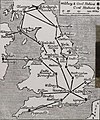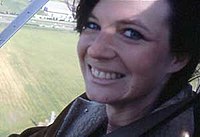Portal:Aviation
| Main page | Categories & Main topics |
|
Tasks and Projects |
The Aviation Portal

Aviation includes the activities surrounding mechanical flight and the aircraft industry. Aircraft includes fixed-wing and rotary-wing types, morphable wings, wing-less lifting bodies, as well as lighter-than-air aircraft such as hot air balloons and airships.
Aviation began in the 18th century with the development of the hot air balloon, an apparatus capable of atmospheric displacement through buoyancy. Some of the most significant advancements in aviation technology came with the controlled gliding flying of Otto Lilienthal in 1896; then a large step in significance came with the construction of the first powered airplane by the Wright brothers in the early 1900s. Since that time, aviation has been technologically revolutionized by the introduction of the jet which permitted a major form of transport throughout the world. (Full article...)
Selected article
Had it been successful, the planned amphibious and airborne landings in Britain of Operation Sea Lion would have followed. The Battle of Britain was the first major campaign to be fought entirely by air forces. It was the largest and most sustained bombing campaign attempted up until that date. The failure of Nazi Germany to destroy Britain's air defence or to break British morale is considered its first major defeat.
British historians date the battle from 10 July to 31 October 1940, which represented the most intense period of daylight bombing. German historians usually place the beginning of the battle in mid-August 1940 and end it in May 1941, on the withdrawal of the bomber units in preparation for the attack on the USSR. (Full article...)
Selected image
Did you know
...that in 1943 British Overseas Airways Corporation Flight 777 was shot down by German Junkers Ju 88s, killing actor Leslie Howard and leading to speculation that it was an attempt to assassinate Winston Churchill? ...that on May 3, 2002 a military MiG-21bis aircraft crashed into the Bank of Rajasthan in India, killing eight? ... that Coast Aero Center and Norving were the first airlines with scheduled services at Geilo Airport, Dagali located in Hol, Norway?
General images -
In the news
- May 29: Austrian Airlines cancels Moscow-bound flight after Russia refuses a reroute outside Belarusian airspace
- August 8: Passenger flight crashes upon landing at Calicut airport in India
- June 4: Power firm helicopter strikes cables, crashes near Fairfield, California
- January 29: Former basketball player Kobe Bryant dies in helicopter crash, aged 41
- January 13: Iran admits downing Ukrainian jet, cites 'human error'
- January 10: Fire erupts in parking structure at Sola Airport, Norway
- October 27: US announces restrictions on flying to Cuba
- October 3: World War II era plane crashes in Connecticut, US, killing at least seven
- September 10: Nevada prop plane crash near Las Vegas leaves two dead, three injured
- August 6: French inventor Franky Zapata successfully crosses English Channel on jet-powered hoverboard
Related portals
Associated Wikimedia
The following Wikimedia Foundation sister projects provide more on this subject:
-
Commons
Free media repository -
Wikibooks
Free textbooks and manuals -
Wikidata
Free knowledge base -
Wikinews
Free-content news -
Wikiquote
Collection of quotations -
Wikisource
Free-content library -
Wikiversity
Free learning tools -
Wikivoyage
Free travel guide -
Wiktionary
Dictionary and thesaurus
Selected biography
Despite her surname, Jeana Yeager is not related to Chuck Yeager, the first man to break the sound barrier in level flight.
Selected Aircraft

The Avro Lancaster was a British four-engine Second World War bomber aircraft made initially by Avro for the British Royal Air Force (RAF). It first saw active service in 1942, and together with the Handley-Page Halifax it was one of the main heavy bombers of the RAF, the RCAF and squadrons from other Commonwealth and European countries serving within RAF Bomber Command. The "Lanc" or "Lankie," as it became affectionately known, became the most famous and most successful of the Second World War night bombers, "delivering 608,612 tons of bombs in 156,000 sorties." Although the Lancaster was primarily a night bomber, it excelled in many other roles including daylight precision bombing, and gained worldwide renown as the "Dam Buster" used in the 1943 Operation Chastise raids on Germany's Ruhr Valley dams.
- Span: 102 ft (31.09 m)
- Length: 69 ft 5 in (21.18 m)
- Height: 19 ft 7 in (5.97 m)
- Engines: 4× Rolls-Royce Merlin XX V12 engines, 1,280 hp (954 kW) each
- Maximum Speed: 240 knots (280 mph, 450 km/h) at 15,000 ft (5,600 m)
- First Flight: 8 January 1941
- Number built: 7,377
Today in Aviation
- 2009 – Batavia Air Flight 711, operated by a Boeing 737-400 made an emergency landing at El Tari Airport, Kupang after a problem was discovered with the landing gear.
- 2001 – Crossair Flight 3597, an Avro RJ100, crashes near Bassersdorf, Switzerland, while attempting to land in Zürich. Of the 28 passengers and five crew members on board, 21 passengers (including dance singer Melanie Thornton of La Bouche) and three crew members died.
- 1992 – China Southern Airlines Flight 3943, a Boeing 737-300, crashes on descent to Guilin Airport, killing all 141 aboard.
- 1991 – Launch: Space Shuttle Atlantis STS-44 at 6:44:00 pm EST. Mission highlights: DSP satellite deployment.
- 1972 – Two USAF McDonnell Douglas RF-4C Phantom IIs of the 363d Tactical Reconnaissance Wing, Shaw AFB, South Carolina, suffer mid-air collision over the Atlantic Ocean about 30 miles off of Pawley's Island at ~1450 hrs. Two crew from one Phantom recovered 27 miles out to sea by Bell UH-1N Huey, Save 53, of Detachment 8, 44th ARRSq, out of Myrtle Beach AFB, but two others including one officer of HQ 9th Air Force, Shaw AFB, are lost.
- 1971 – A man reported as D. B. Cooper hijacks Northwest Orient Airlines Flight 305, a Boeing 727, out of Portland, Oregon, releasing the passengers in exchange for US$200,000 and four parachutes; the crew takes off with Cooper on board, and he parachutes from the plane; Cooper is never found and his fate remains unknown, although a roll of bills from his ransom is found in a riverbed many years later.
- 1970 – Lockheed U-2R, 68-10335, Article 057, seventh airframe of the first R-model order, first flown 30 July 1968, registered N815X, delivered to the CIA 29 August 1968. Crashes at Taoyuan Air Base, Taiwan, on landing after a routine, high-altitude training flight, this date, ROCAF pilot Capt. Denny Huang KWF. At touchdown he skips slightly and begins drifting to starboard. Exacerbated by a 12-knot crosswind, the aircraft leaves the runway, whereupon the pilot applies power to go around. Before the engine spools up, the airframe strikes a six-foot high runway marker. Begins a slow climbing turn to port but nose-high angle causes stall, jet crashes and burns. The Accident Board recommends that the Dash One pilot's manual be amended to emphasize that a go-around should not be attempted after loss of directional control on landing. This was the first loss of an R-model.
- 1968 – Luis Armando Pena Soltren, Jose Rafael Rios Cruz and Miguel Castro coerce the pilot of Pan Am Flight 281 out of New York's John F. Kennedy Airport on a scheduled route to Puerto Rico to divert to Havana, Cuba. Passengers were evacuated from Cuba by a U.S. State Department aircraft. There were no fatalities.
- 1966 – TABSO Flight 101, an Ilyushin IL-18B, crashes into a wooded hillside shortly after takeoff from Bratislava, Czechoslovakia, killing all 82 aboard.
- 1956 – A Boeing B-47E-60-BW Stratojet, 51-5233, c/n 450518, of the 341st Bomb Wing, runs off runway upon landing at Dyess AFB, Texas, tearing away the port inboard engine nacelle. Aircraft may have been also attempting a go-around. All crew survived.
- 1955 – First flight of the Fairchild F-27
- 1953 – A USAF North American F-86D Sabre crashes near Marianna, Florida this date. The pilot ejects but was killed when his chute fails to deploy, his fighter coming down ~10 miles N of Graham Air Base. Col. Lewis H. Norley, commanding officer of the base, said that due to "unknown circumstances" the chute failed to function. Rescue planes from Maxwell Field at Montgomery, Alabama, and Tyndall Air Force Base, Panama City, Florida, discovered the pilot's body. Norley said that the pilot's identity will not be released until notification of the next of kin.
- 1952 – The second Boeing EB-50A Superfortress, 46-003, which spends most of its operational career used for testing, first by Boeing, and later by the Air Research and Development Command, and Air Material Command, primarily at the Aberdeen Proving Ground, is involved in a fatal accident at Aberdeen, Maryland this date. Four crew were killed when it crashed in the Bush River near Edgewood, Maryland.
- 1944 – 111 United States Army Air Forces B-29 Superfortresses attack Tokyo, targeting the Musashino aircraft plant. Although they do not damage the plant, it is the first strategic bombing raid against Japan from the Twentieth Air Force’s new bases in the Mariana Islands, and the first air attack of any kind on Tokyo except for the April 1942 Doolittle Raid.
- 1943 – The Japanese submarine I-175 torpedoes and sinks the U. S. Navy escort aircraft carrier USS Liscome Bay (CVE-56) 20 nautical miles (37 km) southwest of Butaritari with the loss of 644 lives, including that of Rear Admiral Henry M. Mullinnix; there are 272 survivors.
- 1943 – The first Allied aircraft – A damaged U. S. Marine Corps SBD Dauntless dive bomber – Lands on Bougainville.
- 1940 – First BCATP graduates from No. 1 Air Navigation School at Trenton, arrived at Liverpool, England.
- 1939 – BOAC is formed by the merger of Imperial Airways and the original British Airways.
- 1924 – A KLM Fokker F.VII makes the first flight from the Netherlands to the Dutch East Indies, taking 127 hours and 16 minutes.
- 1922 – First flight of the Vickers Virginia
- 1913 – Lieuts. Eric Lamar Ellington and Hugh M. Kelly of the 1st Aero Squadron, United States Army Aviation Corps, are killed this date in a fall of about eighty feet in a Wright Model C, Signal Corps 14. The accident occurred at ~0758 hrs. across the bay from San Diego, California on the grounds of the army school on North Island. On impact, the engine broke free, crushing the two aviators. Ellington Field, Texas, which opens on 1 November 1917, is named for Lt. Ellington.
References
- Shortcuts to this page: Portal:Airplanes • P:AVIA






















































